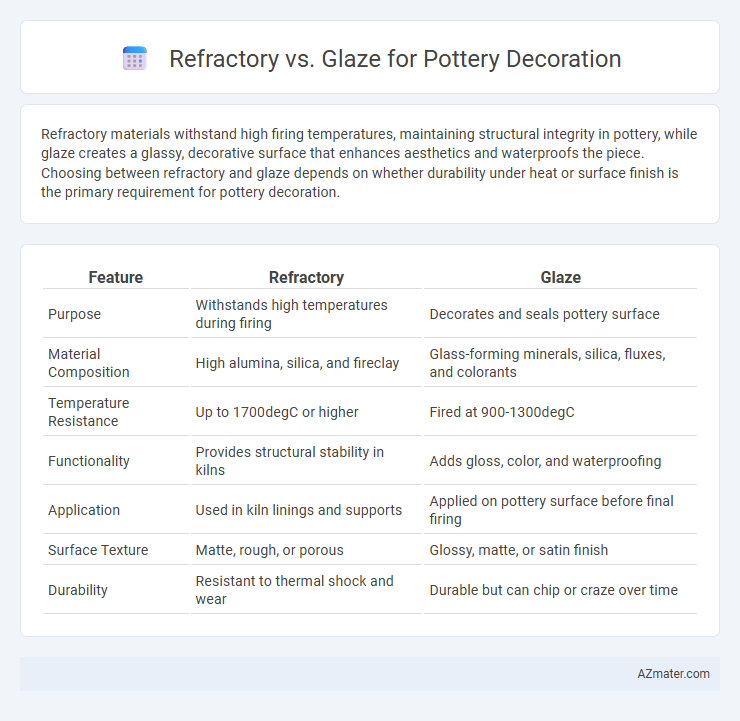Refractory materials withstand high firing temperatures, maintaining structural integrity in pottery, while glaze creates a glassy, decorative surface that enhances aesthetics and waterproofs the piece. Choosing between refractory and glaze depends on whether durability under heat or surface finish is the primary requirement for pottery decoration.
Table of Comparison
| Feature | Refractory | Glaze |
|---|---|---|
| Purpose | Withstands high temperatures during firing | Decorates and seals pottery surface |
| Material Composition | High alumina, silica, and fireclay | Glass-forming minerals, silica, fluxes, and colorants |
| Temperature Resistance | Up to 1700degC or higher | Fired at 900-1300degC |
| Functionality | Provides structural stability in kilns | Adds gloss, color, and waterproofing |
| Application | Used in kiln linings and supports | Applied on pottery surface before final firing |
| Surface Texture | Matte, rough, or porous | Glossy, matte, or satin finish |
| Durability | Resistant to thermal shock and wear | Durable but can chip or craze over time |
Understanding Refractory Materials in Pottery
Refractory materials in pottery are essential for withstanding high firing temperatures without deforming or breaking, ensuring structural integrity during the glaze application process. These materials, typically composed of alumina, silica, and fireclay, provide a durable surface that can endure thermal shock and chemical exposure in kiln environments. Understanding the role of refractory bodies helps potters achieve optimal glaze adhesion and enhances the longevity and aesthetic quality of ceramic pieces.
What is Glaze in Pottery Decoration?
Glaze in pottery decoration is a vitreous coating applied to ceramic surfaces to create a glass-like finish that enhances both aesthetic appeal and durability. It consists primarily of silica, fluxes, and colorants, which fuse during firing to form a smooth, often glossy surface that can be transparent or opaque. Unlike refractory materials designed to withstand high temperatures without melting, glaze transforms the pottery's texture and appearance, providing protection against moisture and wear.
Key Differences Between Refractory and Glaze
Refractory materials in pottery withstand extreme heat without melting or deforming, making them ideal for kiln linings and structural components, whereas glazes are glassy coatings fused to pottery surfaces to provide color, texture, and waterproofing. The key difference lies in their function: refractories focus on thermal resistance and durability, while glazes emphasize aesthetic enhancement and surface protection. Chemically, refractories consist of high-melting-point oxides like alumina and silica, while glazes are composed of silica, fluxes, and colorants that vitrify during firing.
Importance of Refractory in Ceramic Art
Refractory materials in ceramic art are essential for withstanding high temperatures during the firing process, ensuring the structural integrity and durability of pottery. Unlike glazes, which provide decorative and functional surface finishes, refractory components maintain the form and prevent thermal shock or deformation. Their heat resistance is crucial for artists seeking to create long-lasting, robust ceramic pieces that endure intense kiln environments.
Decorative Functions of Glaze in Pottery
Glaze in pottery serves a crucial decorative function by providing a glossy, colorful surface that enhances both texture and visual appeal. Unlike refractory materials that primarily withstand high temperatures, glazes offer a wide range of finishes such as matte, satin, or high gloss, enabling intricate artistic expression and customization. The chemical composition of glazes allows for vibrant hues and complex patterns that are not achievable with bare clay or refractory coatings, making them essential for decorative pottery.
Refractory Applications for Artistic Expression
Refractory materials in pottery decoration serve as essential components for withstanding high firing temperatures, enabling artists to explore intricate designs without compromising structural integrity. These heat-resistant substances allow for layered textures and sculptural forms that maintain their shape and detail even during kiln processes exceeding 1300degC. Utilizing refractory clays and additives expands creative possibilities, supporting durability while fostering innovative artistic expression in ceramic works.
Glaze Types and Their Visual Effects
Glaze types in pottery decoration include glossy, matte, satin, crystalline, and raku, each offering distinct visual effects ranging from shiny and reflective to soft and textured surfaces. Crystalline glazes create unique, intricate patterns through controlled crystal growth, while raku glazes develop crackled and smoky finishes due to rapid cooling. Choosing the right glaze impacts not only the aesthetic appeal but also the durability and functionality of the pottery piece.
Durability: Refractory Coatings vs. Glaze Finishes
Refractory coatings offer exceptional durability by withstanding high temperatures and thermal shock, making them ideal for functional pottery exposed to intense heat. Glaze finishes provide a smooth, glass-like surface that enhances aesthetic appeal but may chip or crack under thermal stress or mechanical impact. Choosing between refractory and glaze depends on the required balance between heat resistance and decorative quality in pottery applications.
Choosing Between Refractory and Glaze for Projects
Selecting between refractory materials and glaze for pottery decoration depends on the intended use and firing temperature of the project. Refractory materials are ideal for pieces exposed to extreme heat or thermal shock, offering durability without melting or altering shape, whereas glaze provides a decorative, glossy or matte finish that enhances aesthetics and adds a waterproof layer. Prioritizing the functional requirements and desired surface effects ensures the right choice for achieving both performance and visual appeal in ceramic art.
Combining Refractory and Glaze Techniques in Pottery
Combining refractory and glaze techniques in pottery enhances both durability and aesthetic appeal by integrating high-temperature-resistant materials with glossy, decorative finishes. Refractory components provide structural strength and thermal shock resistance, while glaze layers contribute to color vibrancy and surface texture. This fusion allows potters to create robust, visually striking pieces that withstand rigorous use and temperature variations.

Infographic: Refractory vs Glaze for Pottery Decoration
 azmater.com
azmater.com